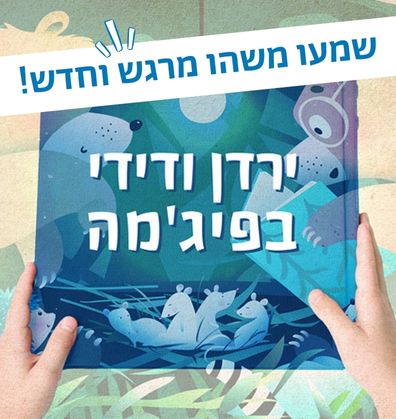טֶבַע וּסְבִיבָה
אביב ופריחה
הביטו סביב הגיע האביב! הטבע מתחדש, פורח ומלבלב, פרפרים צבעוניים, חיפושיות וחרקים - כמה יופי ועניין! בעזרת ספרים על האביב תוכלו לשים לב לחילופי העונות, לחגוג את בואו ולצבור ידע וחוויות סביב הטבע המשתנה.
סְּפָרִים
Book-Related Family Activities
Discussing
“But Robin doesn’t care, she likes sitting on her own like that”: Do you think Robin is really alone? What do you do when you’re on your own? Where do you like to spend your alone time? You may enjoy taking a stroll through the book, and discussing the experiences Robin undergoes when she’s in the tree’s company. Which of Robin’s experiences did you like best?
Illustrations, color, and creativity
This book is rich in color and details that change with each season. You may want to suggest that your child look through the pages, and search for various items: leaves, clouds, fruit, or animals. Perhaps your child can look for the main colors in each page – a red or green page – and draw pictures that are inspired by the book’s illustrations: a green drawing, a yellow one, or a rainbow-colored one.
A game called "What's my Secret?"
How good are you at guessing secrets? You may enjoy playing the following guessing game: Each player in turn picks a “secret” according to a pre-determined topic, such as animals, books, or something found in nature. The other participants must guess what the “secret” is by asking “yes or no” questions.
Environment – Adopting a tree
How about going outside and looking for a tree close to home? What does it look like? What color are its leaves? Perhaps the tree is bare, and has none? Is it bearing fruit? If so, careful! Not all fruit are edible. You could stroke the tree trunk, and notice the birds and other animals nearby. You may want to visit it from time to time to see whether and how it changes throughout the year. With Robin as your inspiration – can you think of a gift that you would want to give your adopted tree?
Datia Ben Dor
was born in Alexandria, Egypt, in 1944, and immigrated to Israel at 12 months. At the beginning of her professional career, Ben Dor engaged in music education, writing scripts and songs for many Israeli children’s television shows, such as Parpar Nechmad (“Lovely Butterfly”), and Rehov Sumsum (the Israeli version of Sesame Street). Her children’s poems and numerous books are well-known and loved, among them Ani Tamid Nishar Ani (“I Always Stay Me”), Digdugim (“Tickles”), Otiyot Mefatpetot (“Chatting Letters”), and Kakha Zeh BeIvrit (“That’s How it is in Hebrew”). Datia Ben Dor has received much recognition for her contribution to children’s literature, such as the ACUM award, and Bialik Prize for Lifelong Achievement in Children’s Literature.
Proposed Family Activities:
- Can your child find Passover symbols in the illustrations? Perhaps you could ask them to point out the four cups, matzah, Passover Haggadah and wine. You may also want to look for clues that spring has arrived – short-sleeved shirts and shorts, flower bloom, and clear skies.
- Do you know the tune to this song? How about singing it together, dancing round and round?
- Springtime beckons us to go outside and enjoy nature. Where do you like to be when you are outdoors? Perhaps you could take this book along with you, take a stroll near your house, and look for signs of spring together.
- You may want to make “spring binoculars” and look through it all around. Decorate two toilet paper rolls with stickers and crayons, and attach them to one another on their long side. What can you see through your binoculars?
- Ma Nishtana? What has changed in your home in preparation for Passover? Young children can also take part in preparing for the holiday, and particularly Seder Night. Perhaps you could invite them to help you set the festive table, sing Passover songs, ask the Four Questions, and look for the Afikoman, of course!
- Datia Ben Dor has written many well-loved poems and stories for toddlers and preschoolers. You may want to look for them at home or in the library, and read them together.
Proposed Family Activities
- You may want to sit close to one another, and read the book together. You could take a good look at the colorful illustrations that accompany the story. How do we illustrate dreams? What colors has the illustrator used? What can we see in the illustrations that does not appear in the text itself? Try to imagine what your dream garden would look like. What would you have liked to grow in it?
- The girl in the story helps her mother take care of her garden. Do you have a garden, or some houseplants? How does your child help you around the house? You may want to remind one another of times and cases in which they were able to lend a helping hand.
- The girl in the story dreams of flowers that never wilt. You too can make such flowers together. You could use tissue paper, pieces of fabric, or even an empty carton of eggs. Perhaps you could tape the flowers to a straw or bamboo skewer, and “plant” them in the garden, or a window box, or even inside an empty water bottle.
- Following this story, you may enjoy discussing dreams and aspirations. Let your imaginations run wild: which of your dreams can come true, and which cannot? What is required in order to make the dream come true?
- It is easy to make chocolate shells, bunnies, and hearts: melt some chocolate with a little oil in the microwave oven, and pour the liquid into small silicone baking molds, or ice-cube trays. It only takes a few minutes in the freezer for the chocolate to harden, and assume the form of the mold!
My Flower
You may want to take the time to leaf through the book together. Which poems did you like best? And which flowers? Unlike a continuous tale, a collection of poetry may be read at any order – you could choose a flower at a time, and read the poem about it together.
Where's the Frog?
There are hidden animals on every page of the book. Your child may want to look for them in the illustrations. Have they found the frog, bees, chameleon, and caterpillar?
Savyon and Ms. Rakefet – the Musical!
You may enjoy drawing and coloring your own Mr. Savyon, Ms. Rakefet, or other characters from the book, glue them onto popsicle sticks, and put on a show based on the poems.
Repeating Rhymes
You may want to read the poems several times. After a while, your child will know them, and finish some rhyming lines for you.
Following Flowers
Which flowers grow near your house? You could take a walk, and look for flowers: taste a wood sorrel (חמציץ, Hamtzitz), touch the thorns of a rose (ורד, Vered), blow on a white Senecio (סביון, Savyon), or smell a wonderful daffodil (נרקיס, Narkis). Are the flowers you found similar to the illustrations in the book?
A Visit to the Nursery
Perhaps you would like to visit a nursery, and choose bulbs, seeds, or a plant in a flowerpot together. Your child could help water the flowers at home, and watch them grow.
מבשלים פנקייקים עם רות סירקיס!
צפו במתכון המיוחד לפסח של רות סירקיס לפנקייקים! מתאים לכל ימי השנה!
Family Activities
The story of the three butterflies was first published in 1938, and has since accompanied many generations of Israeli children. Do you know of an earlier version of the book containing other illustrations? You may want to take a look together at Orit Bergman’s illustrations. Have you noticed that the butterflies’ wings are multicolored? You may like to consider why the illustrator chose to paint the butterflies this way.
The three butterflies look out for one another and refuse to be separated. You may want to discuss friendship and mutual obligation together, be it between friends or family members. Perhaps you’d like to share stories about your friends and your child’s, and the things you enjoy doing together. Following the story, you might want to ask your child if they or their friend had ever been prevented from joining in a game, how that made them feel and what they did in response.
The flowers are only willing to allow those who are of a similar color in. You may want to compare the illustrations of the flowers to those of the butterflies. What similarities and differences can you find between them? You may like to ask your child what they think of the flowers’ behavior.
You may also want to act the story out as a family by dressing up in the colors of the flowers and butterflies. You could also create a puppet theater, with characters for the butterflies and flowers, using popsicle sticks and cellophane.
You might enjoy going outside and looking for butterflies and flowers! Just like in the story, flowers and butterflies in nature differ from one another, each having their own particular color and shape. Have you come across a tulip or lily? How many types of butterflies have you found, and what color were they? Do you happen to know the name of any butterfly? Perhaps you’d like to mimic the way butterflies move, and invent the Butterfly Dance together.
Levin Kipnis wrote hundreds of well-loved children’s poems and stories that form an integral part of Israeli culture. You may wish to look for them at home, in kindergarten, or at the library, and read them together.
Levin Kipnis
Levin Kipnis was one of Hebrew children’s literature’s founding fathers. He wrote and translated many literary pieces for children, and also set up and managed the first children’s theater in Israel. In addition, Kipnis edited numerous journals, anthologies and text books.
He was born in the Ukraine in 1894 and immigrated to what would later become the State of Israel in 1913. He felt there were not enough holiday songs and stories in Hebrew suitable for young children, and proceeded to collaborate with generations of kindergarten teachers in Israel, compiling preschool curricula and authoring hundreds of children’s stories and poems. Among his songs for the Jewish Holidays are: Svivon Sov Sov Sov (“Spin Spin Spin, Dreidel”) for Hanukkah, Ani Purim (“I am Purim”) for Purim, and Saleinu Al Ktefeinu (“Our Baskets are upon our Shoulders”) for Shavuot. His literary pieces contain messages of helping and consideration of others, such as in the famous Eliezer Vehagezer (“Eliezer and the Carrot”), Hamitriya Hagdola shel Abba (“Daddy’s Big Umbrella”), and… Shloshet Haparparim (“The Three Butterflies”).
Levin Kipnis was a particularly prolific author, and won many awards, including the Israel Prize in 1978, and the Hans Christian Andersen Award in 1988. He passed away in 1990.
Family Activities
The lyrics and illustrations in the book mention various Passover symbols. Can your child find the Four Cups, a Matzah, a Passover Haggadah, nuts, and new clothes?
Do you know the tune of this song? You can find it here. What other Passover and springrelated songs do you know? You may want to create an illustrated book of your own together, featuring well-loved Passover songs, from which to sing holiday songs on Seder Night.
The little girl in the book shares the Passover experience with her dolls, and teaches them how Seder Night is conducted. You could also have a Seder Night with your children and their toys, it is a wonderful fun way of getting ready for the holiday.
Passover is the Festival of Spring – a great time to go outdoors and enjoy nature! Where do you like to take trips, and what do you see on your way? Like the little girl in the book, you may like to look for flowers along the way and, if it is permitted, pick them and make a scented bouquet at home.
The book pictorially depicts the festive Passover atmosphere: festive clothes, guests, special food, and family customs. How do you celebrate Passover? You may want to include your child in the preparations for the holiday, as well as Seder Night itself. You could assign them age-appropriate roles, such as helping you tidy up and set the table, sing holiday songs, ask the Four Questions, and of course, look for the afikoman!
Which experiences do you recall from Seder Night as a child? Young children love hearing stories of the past. You may want to share pictures, stories, possibly funny anecdotes of Seder night when you were kids, thereby continuing to strengthen the generation chain of your own family’s unique Passovers. Enjoy reading and discussing the story!
Bilha Yafeh
An authoress, poetess and Israeli educator born in Lithuania in 1891, who immigrated to Israel in 1913, teaching and educating generations of teachers at the David Yellin College of Education in Jerusalem. Yafeh wrote children’s poems, stories and plays. Many of her poems became cultural assets in Israeli children’s literature, among them: Bubba Yemima (Jemima the Doll), Hatul Shovav (Mischievous Cat), and Simcha Rabba (Great Joy). Bilha Yafeh and her husband Mordechai were among the founders of Bet Hakerem neighborhood in Jerusalem, and HaMora (The Teacher) Street was named after them. Bilha passed away in 1961.

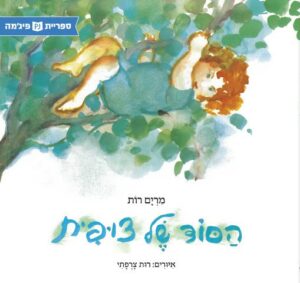 Robin’s Secret
Robin’s Secret  How do You Know that Spring has Come?
How do You Know that Spring has Come? 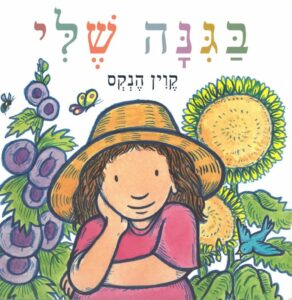 My Garden
My Garden ![כריכת הספר Mr. Savyon [Senecio] and Ms. Rakefet [Cyclamen]](https://www.pjisrael.org/wp-content/uploads/2017/12/מר-סביון-וגברת-רקפת-297x300.jpg) Mr. Savyon [Senecio] and Ms. Rakefet [Cyclamen]
Mr. Savyon [Senecio] and Ms. Rakefet [Cyclamen] 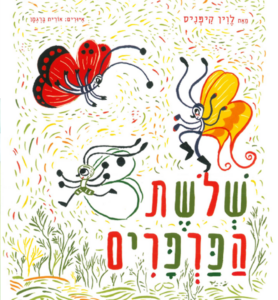 The Three Butterflies
The Three Butterflies 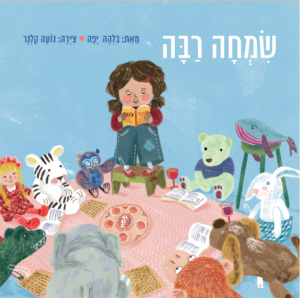 Simcha Rabba (Great Joy)
Simcha Rabba (Great Joy) 
